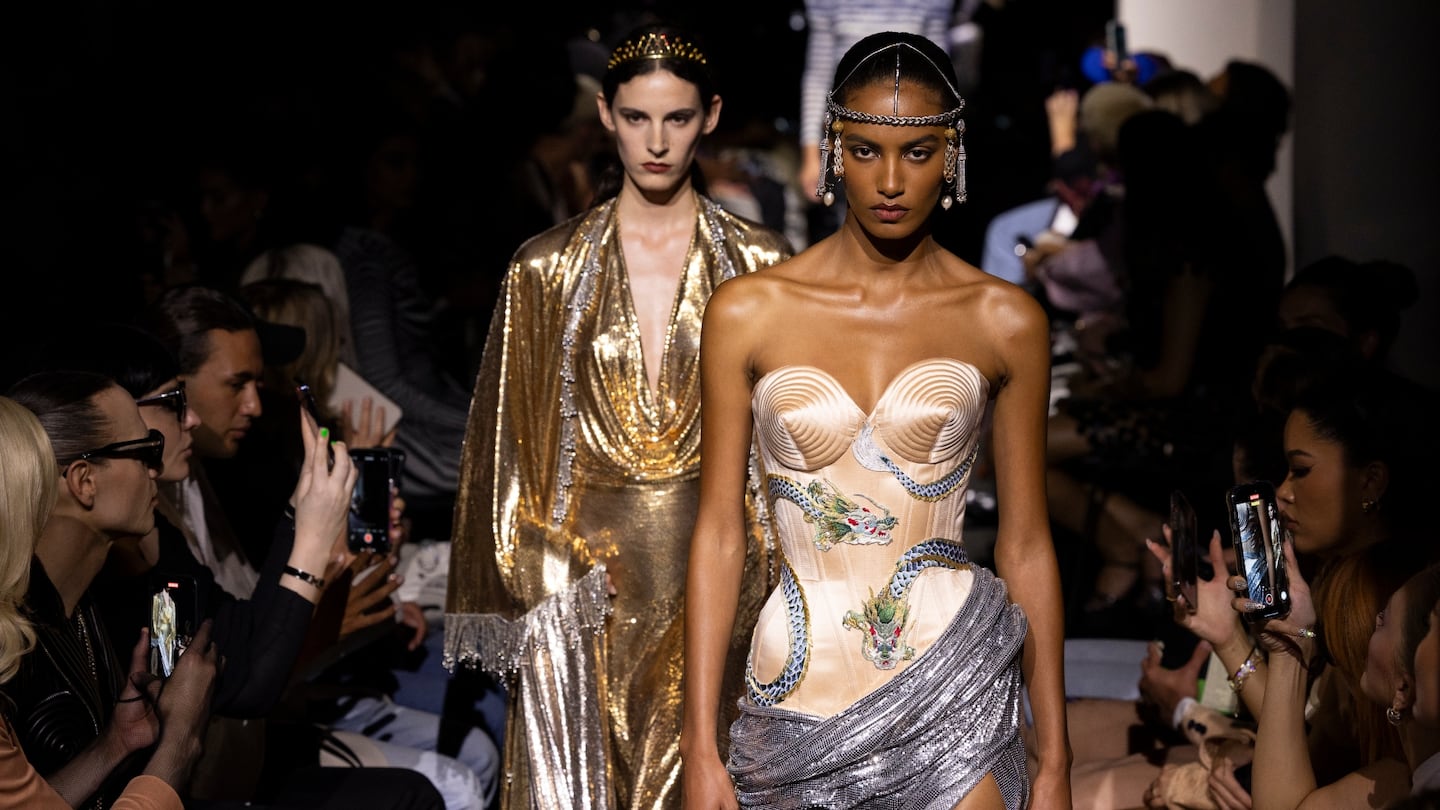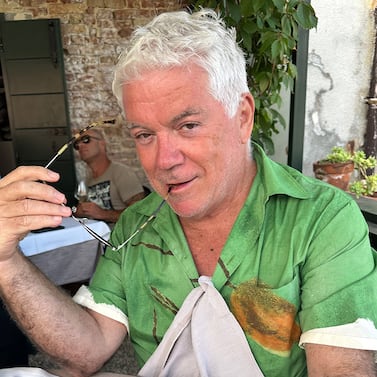
The Business of Fashion
Agenda-setting intelligence, analysis and advice for the global fashion community.

Agenda-setting intelligence, analysis and advice for the global fashion community.

PARIS — Who can save us now? A fully armoured Joan of Arc trundled through Balenciaga’s salons at the close of the couture show on Wednesday. Demna insisted he was making a personal statement about how his work is his protection, “a safe place where I believe I exist.” But the world outside has a habit of catching up with his personal statements. Remember, he intended the huge hole around which his Spring ‘23 show took place as a metaphor for digging his way out of the box the industry put him in, but the war in Ukraine co-opted his intention and turned the hole into a charnel pit. Anyway, Demna’s Joan (actually his muse and frequent model Eliza Douglas) will probably end up being an enduring emblem of this couture season — alongside Daniel Roseberry’s suit of shattered mirrors at Schiaparelli — taking place as it did against a very real backdrop of social unrest in France.
After the show, Demna suggested that fashion itself was in flames, consumed by fakery, marketing, sales, everything that took it away from what mattered: making real clothes, and remembering who they were being made for. “Couture is the only way to shed light on what’s really the essence of this job,” he claimed. He compared it to the Covid vaccine Moderna. “It cannot save [fashion] but it can at least highlight the importance of keeping its immunity. For me, without that, there is no hope.”
So it’s not who but what can save us now? Couture! And Demna set out to convince us of that fact with some eye-popping techniques, uncompromising silhouettes and a fearless attitude. Cristobal Balenciaga Redux, in other words. Demna created a portal to the past in the form of Danielle Slavik, who was Cristobal’s fit model until 1968. The first model out, she wore her favourite dress from her old boss, a black velvet gown strung with pearls. After Demna recreated and gifted it to her, he said she couldn’t say no to him.
The women’s looks that followed featured the upside-down-jacket effect Demna debuted last ready-to-wear. It creates a hyper-structured funnel collar, and it assisted Vittoria Cerretti, in sinuous black velvet with a long train, in her very effective channeling of Morticia Addams. Then came an exercise in trompe l’oeil at its transformative extreme. Linen canvas was laboriously hand-painted by a team of artists to look like a houndstooth blazer, or a fur coat, or a sharkskin suit with all the evil gloss of an oil slick. Cotton was hand-painted as a denim jacket and matching jeans (two and half months to paint a pair of jeans, Demna marveled). Leather was transmogrified into python. The otherwise perfect illusion wasn’t quite complete. The paint stopped a fraction above the hemline. But that was Demna’s tip of the cap to the impossibility of perfection, the bane of Cristobal’s own career.
ADVERTISEMENT
There were coats and scarves frozen as if in mid-gust of wind. There was leopard embroidered into silk crepe, or a polka-dot dress that dissolved into the finest fringing, or other dresses in spirals of red or pink tulle that curled like pasta. Once things started moving, they changed into something else. “Imperfection is about being human and vulnerable,” Demna insisted. Except for the stiff red lace lampshade dress, and Eva Herzigova’s equally unyielding column of glass beads, thousands of them joined together like a piece of jewellery rather than an item of clothing. And then there was that armour: 3D-printed, chromed resin, with a velvet lining. Daniel Roseberry came to mind again, with his anti-AI collection from the other day. “Fashion is easy to imitate, but couture is very hard to copy,” Demna confirmed. AI had, however, been an enormous help in creating his remarkable soundtrack, by helping to separate Maria Callas’s voice from her orchestral backing. She has never been heard as reduced to essence as that before. There must be another metaphor in there somewhere.
0 of 59
This couture season is the fifth time that a guest designer has been selected to interpret Jean Paul Gaultier’s work. The last candidate was Haider Ackermann, who chose to focus on the rigour and purity of Gaultier’s masterful tailoring. His collection was a triumph, raising the bar high for his successor, Paco Rabanne’s young prodigy Julien Dossena.
But Dossena went in the opposite direction on Wednesday. If Gaultier was admired for his technique, he was loved for his gleefully humanistic theatricality. That’s how Dossena discovered him when he was growing up in Brittany. When Gaultier came on TV with his extravagant presentations and his fabulous entourage of characters, nine-year-old Julian saw his future in a flash. “Jean Paul views the world like an extraordinarily creative and talented child, and that’s what I wanted to explore in this collection,” said Dossena.
So, for those with any memory of Gaultier’s peerless string of shows through the 1990s and into the new century, Dossena’s tribute was purest pleasure. He cleverly emphasized the French connection (JPG has always been the most French of designers). The soundtrack’s street noise and footsteps on cobblestones evoked Paris. The outfits were named for Parisian landmarks. “Pere Lachaise”, par exemple, was a black velvet gown draped on the bias, its decolleté filled with real red roses for a merry widow in mourning. A lavishly bullioned tail coat embodied L’École Militaire.” “Galerie Vivienne”, where Gaultier once had his shop and showed his shows, was represented by Laetitia Casta, who first modelled for him 20 years ago, in a crimson velvet dress with a floral bouquet tucked in back like a bunny’s cottontail.
There were echoes of great collections from the past: the concierge’s twinset and tweed skirt; the black satin coat, “religieusement,” with the chapka, from the controversial “Chic Rabbis” collection; Eve naked under a sheer slip dress with a merkin of black pearls, from the “Adam and Eve” show. And there were also Gaultier’s design signatures, like the Breton stripe, the punk tartan, the underwear as outerwear and the bustiers with cone breasts.
But Dossena’s show was no mere exhumation of another designer’s past. The invitation credited “Jean Paul, Julien, Paco et Les Autres.” A significant part of the collection incorporated the metal mesh that was Paco Rabanne’s major contribution to fashion’s vocabulary, spectacularly so in pieces like the dragon-embroidered corset with the long silver skirt or the gold draped dress with the floral satin lining, accompanied by an Olympian headdress of golden leaves.
I’m not sure who “Les Autres” are. Maybe the designers who are still to come in what has turned into the most enjoyable initiative in fashion.
0 of 33
How does haute couture cope in Paris when real life intrudes, asks Tim Blanks.
The schedule has started to reflect a clientele increasingly centred in Asia, the Middle East and other regions beyond the traditional core of Europe and North America.

Tim Blanks is Editor-at-Large at The Business of Fashion. He is based in London and covers designers, fashion weeks and fashion’s creative class.
From where aspirational customers are spending to Kering’s challenges and Richemont’s fashion revival, BoF’s editor-in-chief shares key takeaways from conversations with industry insiders in London, Milan and Paris.
BoF editor-at-large Tim Blanks and Imran Amed, BoF founder and editor-in-chief, look back at the key moments of fashion month, from Seán McGirr’s debut at Alexander McQueen to Chemena Kamali’s first collection for Chloé.
Anthony Vaccarello staged a surprise show to launch a collection of gorgeously languid men’s tailoring, writes Tim Blanks.
BoF’s editors pick the best shows of the Autumn/Winter 2024 season.